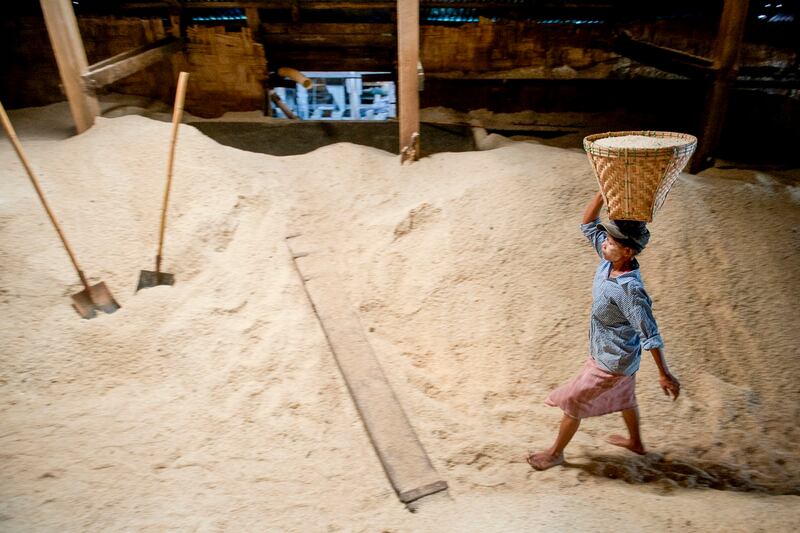These days, when Aung Paing looks around the 500-acre salt farm in southern Myanmar’s Ayeyarwaddy region, he sees fewer and fewer harvesters. Most have left Kant Ba Lar village, where the farm is located, to find jobs in cities such as Yangon or in neighboring countries.
It’s no wonder – the work conditions are brutal and the pay is poor.
Aung Paing earns 200 kyats (10 US cents) for every pair of baskets he hauls containing salt from ponds used for evaporating seawater to the farm’s packaging area in Labutta township.
He typically earns around 8,000 kyats (US$3.80) a day, toiling in temperatures he describes as “hot as the boiling water in a kettle.” His wages account for a fraction of what he needs to support his family of five, he says.
But while Aung Paing, from nearby Sar Kyin village, wishes he could stop hauling salt for a living, he says he has no other choice.
“I don't want to work this job anymore, but I can’t leave as I am struggling to provide for my family,” he said. “I have no other choice for a job.”
Myo Min Tun, from Labutta’s Ka Pyo village, has spent 13 years working at a salt farm. He typically earns 7,000-10,000 kyats (US$3.35-4.75) per day, but it’s barely enough to feed his family of five.
“As commodity prices are increasing, we are facing many challenges in daily life,” he says. “My daily income is just enough for expenses each day, but we can’t save any money.”

Myint Kyi, a salt farmer in his 60s, told RFA Burmese that the higher inflation becomes, the more salt harvesters are willing to take a chance on finding new work that can earn them a better wage.
“Salt harvesters earn just enough for basic foods,” he said. “The income and expense imbalance creates several challenges in the community. Basic commodity prices for rice, onions and cooking oil, as well as fish and prawns, are now increasing.”
Market instability
Salt production in Labutta township began around 1960, when farms used pans to boil off seawater.
The nearly 150 farms in Labutta now pump seawater through five levels of filtration to drying ponds, where fine crystals are formed after a 20-day evaporation process. The salt is then transported to factories in Pathein and Yangon, 130 kilometers (80 miles) north and 250 kilometers (155 miles) northeast.
Last year, one viss (3.5 pounds) of raw salt sold for 140 kyats (7 US cents), but the same amount now fetches only 90 kyats (4 US cents) at the market.
It’s for this reason, says Tin Win, the chairman of the Salt Fields Supervisory Committee of Kant Ba Lar village, that salt farm owners can’t increase wages to match the rising price of commodities, and workers are quitting their jobs.
"We now have only two-thirds of the workforce, compared to that of previous years,” he said. “In the past, there were 10 regular workers, but we now have only seven. The salary of each salt harvester is from 180,000-200,000 kyats (US$85-95), and it isn’t enough income for families with three to five dependents.”

Salt can only be produced between February and May each year, prior to the start of the rainy season.
The shortage of salt workers has caused a delay in production, while this year’s harvesting season was cut short due to an early monsoon, and farm owners say they have suffered losses.
But while farm owners are lobbying to set a standard price for salt to create stability in the market, workers are hoping for a drop in the price of commodities so that they can make ends meet on their meager salaries.
Translated by Aung Naing. Edited by Joshua Lipes and Malcolm Foster.
